모유수유, 유방 구조, 모유수유 호르몬 프로랙틴에 관한 백문 백답, One Hundred Q&A on breastfeeding, anatomy of breasts, prolactin hormone
|
다음은“모유수유, 유방 구조, 모유수유 호르몬 프로랙틴”에 관한 백문 백답입니다. |
Q.&A. 모유수유, 유방 구조, 모유수유 호르몬 프로랙틴에 관한 백문 백답
Q. 유방이란?
A.젖샘(Mammry gland/breast), 즉 유방은 모유를 생성하는 외분선이다. 여성 생식기계의 일부이다. 유방은 앞가슴의 피하조직, 2~6번째 늑골의 사이, 대흉근육, 흉골과 겨드랑이 사이에 위치하고 있다. 유방의 중앙 부위에 젖꼭지가 있다. 젖꼭지를 유두라고 한다. 젖꼭지는 양쪽 유방에 하나씩 있다. 그 유두의 뿌리를 둘러싼 피부부분을 유두륜, 유륜, 젖꼭지판, 또한 젖무리라고 한다. 유륜에는 몽고메리선이 있다. 여기서 피지가 분비된다. (그림 22-41 참조)
Q. 유방의 내부의 구조는?
A. 한 개의 유방 속에는 15~20개 젖샘엽이 있다. 각 젖샘엽에는 유선(포상샘/ 포상선/젖샘)이 많이 있다.
그 포상샘은 포상샘 분비관에 연결되어 있다. 그 포상샘 분비관은 팽대부(유동)로 연결되어 있다. 그 팽대부(유동)는 다시 유관(젖샘관)으로 연결되어 있다. 그 유관은 유두의 젖 구멍으로 연결되어 있다. 유두의 젖 구멍에서 젖이 나온다. (그림 유방 참조)
Q. 유방에서 젖이 만들어지는 경로는?
A. 아기가 젖을 먹을 때 꼭지를 빨 으면서 유륜을 자극하면→ 신경 임펄스가 뇌 시상하부로 전달되고→ 시상하부에서 뇌하수체 후엽으로 신호를 보내어 옥시토신(피토신)분비되고→ 옥시토신은 포상샘을 둘러싸고 있는 근상피세포를 자극하고→ 포상샘(유선)에서 젖(모유)이 분출되고→ 포상샘 분비관→ 팽대부→ 유관(젖샘 관)→ 유두→ 유두 젖구멍을 통과해 젖이 분비된다. 결합조직과 지방조직이 각 젖샘 엽 사이에 있다.
Q. 유방은 어떻게 발육되나?
A.사춘기가 되기 전 까지 남,여아의 유방의 구조는 거의 같다.
사춘기가 시작되면 여성의 난소의 황체에서 분비되는 에스트로겐과 프로게스테론이라는 여성호르
몬에 의해서 유선(젖샘)과 포상샘 분비관(젖분비관) 등이 발육되고 커진다. 그리고 지방조직이 유방 속에 축적된다. 그래서 사춘기 여아들의 유방이 예쁘게 커진다.

사진 4-2.모유수유로 아기를 양육하면 아기에게 이롭고 좋은 점이 참 많다. 모유수유를 하는 동안 엄마의 살갗과 아기의 살갗이 서로 접촉될 때 생기는 신체적 접촉사랑, 거기다가 엄마가 주는 집중적 관심적 사랑 및 보살핌을 받을 수 있는 것은 또한 아기에게도 이롭고 엄마에게도 이롭다. 이런 사실이 있다는 것을 알게 모르게 그냥 지나가고 있다. 젖 먹는 아기는 엄마의 눈길접촉 사랑을 받을 수 있고 엄마 역시 아기로부터 눈길접촉 사랑을 받을 수 있다. 이런 사랑은 모유수유를 하는 중 젖을 먹는 아기와 수유모에게만 생긴다. Copyright ⓒ 2013 John Sangwon Lee, MD., FAAP
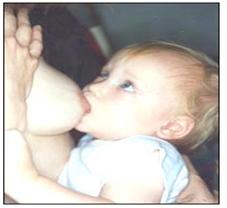
사진 4-3.젖 먹는 아기의 눈길을 보라! 엄마의 눈길과 아기의 눈길 접촉사랑을! 바로 이런 눈길 접촉사랑을 통해 모자간의 사랑의 반딩( love Bonding)이 굳건히 형성된다. 이런 사랑의 반딩(Bonding)은 모유수유를 할 때 더 굳건히 형성된다. Copyright ⓒ 2011 John Sangwon Lee, MD., FAAP
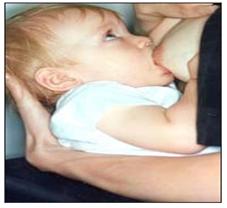
사진 4-4.젖 먹는 아기의 눈길을 보라! 엄마의 눈길과 아기의 눈길 접촉사랑을! 바로 이런 눈길 접촉사랑을 통해 모자간의 사랑의 반딩(love Bonding)이 더 굳건히 형성된다. Copyright ⓒ 2011 John Sangwon Lee, MD., FAAP
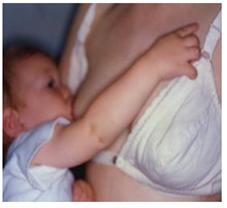
사진 4-5. 젖 먹는 아기의 신체적 접촉 사랑을 보라! 엄마의 신체와 아기 간 신체적 접촉사랑을! 바로 이런 신체적 접촉사랑을 통해 모자간의 사랑 반딩( love Bonding)이 더 굳건히 형성된다. Copyright ⓒ 2011 John Sangwon Lee, MD., FAAP
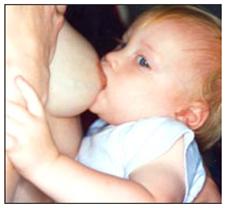
사진 4-6. 젖 먹는 아기의 신체적 접촉을 보라! 엄마의 신체와 아기의 신체적 접촉사랑을! 바로 이런 신체적 접촉사랑을 통해 모아간의 사랑 반딩(love Bonding)이 더 굳건히 형성된다. Copyright ⓒ 2011 John Sangwon Lee, MD ., FAAP
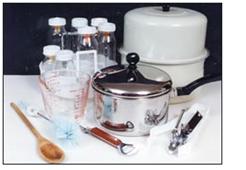
사진 4-7.인공영양을 먹이기 위해 필요로 하는 것들이 더 많이 있다. Copyright ⓒ 2011 John Sangwon Lee, MD., FAAP
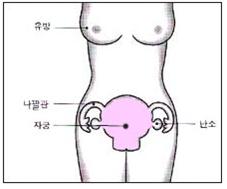
그림 4-1. 분만 후 모유수유를 하지 않는 산모의 자궁은 피토신 호르몬의 영향을 적게 받아 서서히 수축되고 서서히 회복된다. Copyright ⓒ 2011 John Sangwon Lee, MD., FAAP
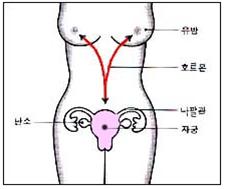
그림 4-2. 분만 후 모유수유를 하는 산모의 자궁은 피토신 호르몬의 영향을 받아 더 빨리 수축되고 회복된다. Copyright ⓒ 2011 John Sangwon Lee, MD., FAAP
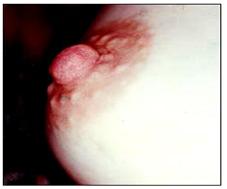
사진 4-8. 유두륜(유륜, 젖꼭지판)에 두드러지게 나온 여러 개의 작은 결절들이 있다. 그 결절들을 몽고메리 결절이라고 한다. 몽고메리 결절 속에 몽고메리 분비선이 있다. 거기에서 크림과 같은 윤활성 피지가 분비된다. Copyright ⓒ 2011 John Sangwon Lee, MD., FAAP

사진 4-9. 모유는 데우지 않아도 언제든지 먹을 수 있게 온도가 적절하다. 사진에서 유륜에 나있는 몽고메리 돌기 끝부분이 선명하게 보인다. Copyright ⓒ 2011 John Sangwon Lee, MD., FAAP
Q. 임신하면 유방에도 변화가 온다고 하던데?
A. 임신이 되면 임신부의 신체에 많은 변화가 현저하게 생긴다.
그 중 더 특별하고 현저하게 생기는 신체적 변화는 자궁과 유방에 오는 변화이다.
장차 태어날 아기가 젖을 먹고 자라건 인공영양을 먹고 자라건 임신부는 장차 태어날 내 소중한 아기가 젖을 충분히 먹고 건강하게 자랄 수 있게 유방 속 포상샘과 젖 분비 세포 및 젖 분비선계가 발달된다.
유방 속에 유선관(포상샘 분비관계), 팽대부, 유관(젖샘 관) 등이 왕성하게 발달하고 젖꼭지가 커지고 유방 내 지방조직이 축적되고 유방 전체가 커진다.
유륜에 몽고메리선이 발달되어 거기서 피지가 생성되어 모유를 수유하기에 더 편리하게 유방 모든 것이 착착 진행된다.
유방이 탄탄하게 커지는 처음 얼마동안에는 좀 얼 얼거리고 아플 수 있다. 특히 유두가 어디에 닿으면 상당히 아플 수 있다.
한 개의 유방 안에는 15~20개의 유방 엽이 있다.
한 개의 유방 엽은 여러 개의 작은 유방 소엽들로 구성되어 있고,
유방 소엽들은 다시 더 세분된다.
그 유방소엽 속에 젖을 만드는 젖 세포들이 있다.
젖 세포들이 모여 젖선(포상샘)이 된다.
이 젖샘을 포상샘, 또는 유선이라고도 한다.
젖 선(腺)에서 만들어진 젖이 흘러가는 관을 포상샘 분비관이라 한다. 크고 작은 포상샘 분비관을 통틀어 포상샘 분비관계라고 한다. (그림 유방 참조)
아기가 젖꼭지를 빨아 먹기 전에 젖 선에서 분비된 젖이 괴여 있는 유방 속 동을 유동 또는 팽대부라고 한다. 임신이 되자마자 이런 유방 내부 젖분비선계의 조직이 점점 더 커지고 발달된다. 그리고 분만하기 바로 전까지 유방의 기능이 알게 모르게 더 활성화된다.
임신 중 태반에서 분비되는 항 프로택틴 호르몬(Antiprolactin hormone)의 작용으로 프로랙틴(Prolactin)이 포상샘의 젖 분비세포를 자극해서 젖이 분비되지 못하게 작용하고 있다가 아기가 태어난 후 태반이 자궁 속에서 배출 되자마자 프로랙틴이 젖분비 세포들을 자극하기 시작하고 젖분비 세포들이 젖을 만들기 시작한다. 그러나 프로랙틴이 분만 후 왕성하게 작용하기 시작하는 데는 1~2일의 시간이 필요하다.
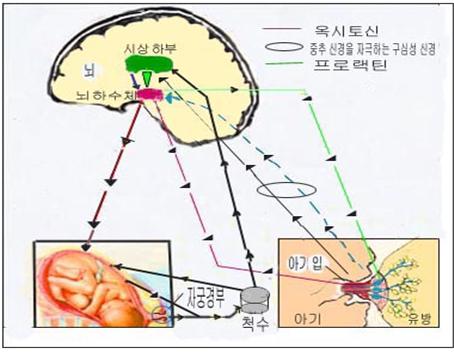
그림 4-3. 모유 분비, 자궁경관의 확장, 모유분비 자극 호르몬(프로랙틴), 유방의 유동 내로 모유를 분출시키는 옥시토신 호르몬, 젖꼭지를 빨 때 생길 수 있는 프로랙틴 호르몬 분비, 프로랙틴 분비 억제 호르몬. Copyright ⓒ 2011 John Sangwon Lee, MD ., FAAP
Q. 유방은 어떻게 젖을 만들어내나?
A. 아기가 젖꼭지를 빨 때는 젖꼭지와 유륜 등에 있는 말초 신경이 자극 받는다. 이 때 아기가 젖을 빤다는 신호가 신경 임펄스(neural impulse)를 통해 수유모의 뇌에 있는 시상하부로 전달된다.
시상하부에서 신경 임펄스가 수유모의 뇌하수체의 후엽에 전달된다.
수유모의 뇌하수체 후엽에서 옥시토신(Oxytocin/pitocin)호르몬이 분비되고 그 옥시토신 호르몬은
포상샘 세포를 싸고 있는 근상피세포를 자극해서 모유가 포상샘 분비관으로 분비되게 한다.
유방 내 젖 세포에서 유방 젖 분비관계 속 유동 속으로 이미 분비되어 있는 모유가 포상샘 분비관계(유관) 등을 통해 젖꼭지 쪽으로 흘러나오도록 포상샘 분비관계를 자극한다.
그와 동시에 젖꼭지를 빨 때 생긴 신경 임펄스가 수유모의 시상하부로 전달되고 그 다음 뇌하수체 전엽에 전달된다.
프로랙틴(Prolactin)호르몬이 수유모의 뇌하수체의 전엽에서 분비된다. 그 프로랙틴 호르몬은 유방의 젖 분비세포(젖 세포)를 자극해 젖 분비를 촉진시킨다.
그와 동시에 유방 내 혈액 순환이 더 왕성해지고 유방 내 지방조직이 더 발달되고 지방이 유방 안에 더 축적된다.
유방의 피하 조직에 있는 정맥 혈관들이 유방 피부층을 통해 육안으로 쉽게 볼 수 있을 정도로 커진다.
임신 중 유방이 커지기 때문에 유방의 피부층에 신장반(임신선)이 생길 수 있다.
분만 후 아기가 젖을 빨 때 신경 임펄스가 시상하부로 전달되고 그 다음 뇌하수체 후엽으로 전달된다.
뇌하수체 후엽에서 옥시토신이 분비되어 모유가 분출된다. 임신 중에는 태반에서 분비되는 프로랙틴 분비 억제 호르몬에 의해서 아기가 태어나기 전에는 프로랙틴이 유방을 자극 할 수 없다.
모든 이런 생리를 배우다 보면 우리 몸의 생리는 컴퓨터 칩의 기능과 비슷하게 만들어 졌다고 생각 한다.
Q. 임신 중 젖꼭지와 유두륜에 크림 같은 것이 생기면 씻어내야 하나?
A. 임신 중 유두는 보통 때 크기의 배로 커지고 유두의 끝 부분에 15~20개 정도 젖나오는 구멍들이 있다.
유두의 뿌리의 주위에 있는 유륜(유두륜)의 크기도 배로 커진다. 유두와 유륜의 색은 짙은 흑갈색이거나 또는 진분홍색으로 변한다.
아마도 젖 먹는 아기가 육안으로 쉽게 보고 쉽게 찾을 수 있게 유두와 유륜의 색이 이렇게 변화된 것 같다.
유륜에는 몽고메리 결절이 여러 개 정상적으로 나있다. 그 몽고메리 결절 속에 몽고메리 선이 있고 거기에서 크림과 같은 윤활 피지가 분비돼 유륜과 유두를 부드럽게 해서 수유 중 유두와 유륜이 갈라지거나 터지지 않게 하는 역할을 한다.
즉 기계가 잘 돌아가도록 기계에 기름을 치는 것과 거의 같은 이치이다.
임신 기간 동안과 분만 후 모유수유하는 동안 윤활 피지는 유두와 유륜을 보호해 주는 역할을 한다.
몽고메리 선에서 분비된 크림 같은 윤활 피지를 비누로 씻어내서는 안 된다. 그리고 유두나 유륜에 국소 도포용 크림을 특별히 바를 필요도 없다.
Q. 유방의 크기가 작은 편인데 아기한테 충분한 양의 모유가 나올까?
A.임신부에 따라 유방의 크기와 모양에 차이가 많다.
유방의 크기가 상당히 크던 작던 늘어졌던 탄탄하던 모든 산모의 유방은 한 아기 또는 두 아기가 동시 먹고 자랄 수 있도록 충분한 양의 모유를 분비할 수 있다.
소아청소년과 의사가 바라는 유방의 궁극적인 목적은 안정하고 편안한 느낌을 아기에게 주고 아기가 먹고 건강하게 자랄 수 있게 따뜻한 모유를 충분히 분비하는 것이다.
임신 5~6 개월경부터 유두에 있는 여러 개의 젖 구멍에서 맑은 젖이 몇 방울 정도 나올 수 있다. 이 젖은 초유의 일종이다. 이 젖은 마유라고도 한다.
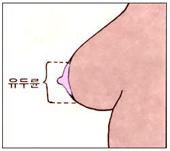
그림 4-4. 유방과 유두륜
Copyright ⓒ 2011 John Sangwon Lee, MD ., FAAP
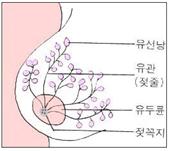
그림 4-5. 모유수유와 유방
Copyright ⓒ 2011 John Sangwon Lee, MD., FAAP
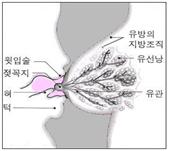
그림 4-6. 모유수유를 할 때 아기의 입과 유방과 젖꼭지의 상관관계도
Copyright ⓒ 2011 John Sangwon Lee, MD., FAAP
| 임신하지 않은 성인 여성의 유방, 임신한 성인 여성의 유방, 모유수유하는 성인 여성의 유방의 그림 |

그림 4-7. 임신하지 않은 여성의 유방(a), 임신한 여성의 유방(b), 수유하는 여성의 유방(c)을 비교.
-
임신하지 않은 여성의 유방은 가장 작다. 포상샘, 포상샘 분비관, 유동, 젖샘관(유관)이 수유모의 유방에 있는 것들에 비해 훨씬 더 작기 때문이다.
-
임신한 여성의 유방은 모유분비선계가 더 잘 발달되어 있고 더 커졌다.
-
수유하는 여성의 유방은 가장 크고 지방조직이 눈에 띄게 많다. 포상선(포상샘)도 크게 잘 발달됐다. 포상샘 분비관이 더 크고 유동(팽대부)도 더 크고 젖샘관(유관)도 더 크다. 젖꼭지도 유륜도 크다. 소스: Used with permission from Ross Laboratories, Columbus, Ohio 43216, Division of Laboratories, USA와 소아가정간호백과
표 성숙 모유, 이행성(변이) 모유, 초유, 우유의 성분 비교표 Composition of mature breast milk, transitional breast milk, colostrum and cow’s milk
|
모유, 초유 우유
성분 |
모유 | 우유 | ||||||
| 분만 후 15일부터 15개월 동안 분비되는
성숙 모유 |
분만 후 6일에서 10일 동안 분비되는
이행성 모유 |
분만 후 첫 5일 동안에 분비되는
초유 |
||||||
| 평균 | 시험범위 | 평균 | 시험범위 | 평균 | 시험범위 | 평균 | 시험범위 | |
| 칼로리 (kcal/liter) | ||||||||
| 747 | 446-1192 | 735 | 678-830 | 671 | 588-730 | 701 | 587-876 | |
| ml/liter | 3.127 | 1.867-4.989 | 3.076 | 2.838-3.474 | 2.808 | 2.461-3.055 | 2.934 | 2.457-3.666 |
| 비중 | 1.031 | 1.026-1.037 | 1.035 | 1.034-1.036 | 1.034 | – | 1.031 | 1.028-1.033 |
| 수소 이온 농도 지수 | 7.01 | 6.4-7.6 | – | – | – | – | 6.6 | – |
| 고형질, 총 (g/liter) | 129 | 103-175 | 133 | 105-156 | 128 | 100-167 | 124 | 119-142 |
| 회분, 총 (g/liter) | 2.02 | 1.6-2.66 | 2.67 | 2.31-3.38 | 3.08 | 2.47-3.50 | 7.15 | 6.81-7.71 |
| 미네랄 (g/liter) | – | – | – | – | – | – | – | – |
| 양성전자원소 (㎎/liter) | 41 | – | 55 | – | 68 | – | 149 | 0.390-0.139 |
| 소듐 (g/liter) | 0.172 | 0.064-0.436 | 0.294 | 0.192-0.539 | 0.501 | 0.265-1.37 | 0.768 | 0.392-0.139 |
| 0.189 | 0.080-0.350 | 0.536 | 0.170-1.21 | 0.956 | 0.330-2.24 | – | – | |
| 포타슘 (g/liter) | 0.512 | 0.373-0.635 | 0.636 | 0.528-0.769 | 0.745 | 0.658-0.870 | 1.43 | 0.38-2.87 |
| 0.553 | 0.425-0.735 | 0.692 | 0.450-0.910 | 0.581 | 0.220-0.790 | – | – | |
| 칼슘 (g/liter) | 0.344 | 0.173-0.609 | 0.464 | 0.23-0.628 | 0.481 | 0.242-0.656 | 1.37 | 0.56-3.81 |
| 0.271 | 0.207-0.372 | 0.320 | 0.166-0.420 | 0.261 | 0.180-0.364 | – | – | |
| 마그네슘 (g/liter) | 0.035 | 0.018-0.057 | 0.035 | 0.026-0.054 | 0.042 | 0.031-0.082 | 0.13 | 0.07-0.22 |
| 음성전자원소 (㎎/liter) | 28 | – | 37 | – | 40 | – | 108 | – |
| 인 (g/liter) | 0.141 | 0.068-0.268 | 0.198 | 0.097-0.317 | 0.157 | 0.085-0.251 | 0.91 | 0.56-1.12 |
| 황 (g/liter) | 0.14 | 0.05-0.30 | 0.20 | 0.15-0.23 | 0.23 | 0.20-0.26 | 0.30 | 0.24-0.36 |
| 염소 (g/liter) | 0.375 | 0.088-0.734 | 0.457 | 0.305-0.721 | 0.586 | 0.435-1.01 | 1.08 | 0.93-1.41 |
| 과양성 원소 (㎎/liter) | 13 | – | 18 | – | 28 | – | 41 | – |
| 극소물질 | ||||||||
| 코발트 (㎎/liter) | 극소 | – | – | – | – | – | 0.6 | – |
| 철 (㎎/liter) | 0.50 | 0.20-0.80 | 0.59 | 0.29-1.45 | 1.0 | – | 0.45 | 0.25-0.75 |
| 동 (㎎/liter) | 0.51 | – | 1.04 | – | 1.34 | – | 0.102 | – |
| 망간 (㎎/liter) | 극소 | – | 극소 | – | 극소 | – | 0.02 | 0.005-0.0067 |
| 아연 (㎎/liter) | 1.18 | 0.17-3.02 | 3.82 | 0.39-5.88 | 5.59 | 0.72-9.81 | 3.9 | 1.7-6.6 |
| 불소 (㎎/liter) | 0.107 | 0.0-0.24 | – | – | 0.131 | 0.0-0.35 | – | 0.10-0.28 |
| 옥소 (㎎/liter) | 0.061 | 0.044-0.093 | – | – | – | 0.045-0.450 | 0.116 | 0.036-1.05 |
| 셀레늄 (㎎/liter) | 0.021 | – | – | – | – | – | 0.04 | 0.005-0.067 |
| 단백질 (g/liter) | ||||||||
| 총 | 10.6 | 7.3-20 | 15.9 | 12.7-18.9 | 22.9 | 14.6-68.0 | 32.46 | 28.16-36.76 |
소스와 참조 문헌: Nelson textbook, 15 Edition p.121,
Pediatric nutrition handbook, American Academy of pediatric, p.354
그 외
|
모유, 초유 우유
성분 |
모유 | 우유 | |||||||
| 분만 후 15일부터 15개월 동안 분비되는 성숙 모유 | 분만 후 6일에서 10일 동안 분비되는 이행성 모유 | 분만 후 첫 5일 동안에 분비되는 초유 | |||||||
| 성분 | 평균 | 시험범위 | 평균 | 시험범위 | 평균 | 시험범위 | 평균 | 시험범위 | |
| 탄수화물 | |||||||||
| 유당 | |||||||||
| 직접추정 (g/liter) | 71 | 49-95 | 64 | 61-67 | 57 | 11-79 | 47 | 49-50 | |
| 차이 | 68 | 50-92 | 64 | 60-68 | – | – | – | – | |
| 과당 (g/liter) | 1.3 | – | – | – | – | – | – | – | |
| 글루코사민 (g/liter) | – | 0.7-0.8 | – | – | – | 1.4-4.3 | 0 | – | |
| 갈락토사민 (g/liter) | – | 0.0-0.4 | – | – | – | 0.04-0.7 | 0 | – | |
| 이노시톨 (g/liter) | 0.45 | 0.39-0.56 |
– |
– | – | – | 0.08 | 0.06-0.12 | |
| 구연산 (g/liter) | – | 0.35-1.25 | – | – | – | – | 2.54 | 2.15-2.9 | |
| 지방, 총 (g/liter) | 45.4 | 13.4-82.9 | 35.2 | 27.3-51.8 | 29.5 | 24.7-31.8 | 38.0 | 34.0-61.0 | |
| 콜레스테롤 (㎎/liter) | 139 | 88-202 | 241 | 126-320 | 280 | 180-345 | 110 | 70-170 | |
| 자유콜레스테롤 (총양의 %) | 76.1 | – | 76.5 | – | 79.5 | – | – | 90-95 | |
| 인 지질 (㎎/liter) | 10.5 | 7-14 | 15.5 | 11-20 | 12 | 6-17 | – | 53-70 | |
| 비타민 | |||||||||
| 비타민A (㎎/liter) | 0.61 | 0.15-2.26 | 0.88 | 0.58-1.83 | 1.61 | 0.75-3.05 | 0.27 | 0.17-0.38 | |
| 캐토틴 (㎎/liter) | 0.25 | 0.02-0.77 | 0.38 | 0.23-0.63 | 1.37 | 0.41-3.85 | 0.37 | 0.12-0.79 | |
| 비타민 D (IU/liter) | – | 4-100 | – | – | – | – | – | 5.40 | |
| 토코페롤 (㎎/liter) | 2.4 | 1.0-4.8 | 8.9 | 4.0-18.5 | 14.8 | 2.8-30.0 | 0.6 | 0.2-1.0 | |
| 지아민 (㎎/liter) | 0.142 | 0.081-0.227 | 0.059 | 0.023-0.105 | 0.019 | 0.009-0.034 | 0.43 | 0.28-0.900 | |
| 리보플라빈 (㎎/liter) | 0.373 | 0.198-0.790 | 0.369 | 0.275-0.490 | 0.302 | 0.120-0.453 | 1.56 | 1.16-2.02 | |
| 비타민 B6 (㎎/liter) | 0.18 | 0.10-0.22 | – | – | – | – | 0.51 | 0.40-0.63 | |
| 니코틴 산 (㎎/liter) | 1.83 | 0.66-3.30 | 1.75 | 0.60-3.60 | 0.75 | 0.50-14.5 | 0.74 | 0.50-0.86 | |
| 비타민 B₁₂ (㎍/liter) | – | 극소량 | 0.36 | 0.03-0.70 | 0.45 | 0.10-1.5 | 6.6 | 3.2-12.4 | |
| 엽산 (IU/liter) | |||||||||
| (a) | 1.4 | 0.9-1.8 | 0.2 | 0.15-0.25 | 0.5 | 0.10-1.5 | 1.3 | 0.2-4.0 | |
| (b) | 24.0 | 7.4-61.0 | – | – | – | – | 37.7 | 16.8-63.2 | |
| (c) | 7.3 | 2.3-17.6 | – | – | – | – | 12.6 | 2.8-43.6 | |
| 바이오틴 (IU/liter) | 2 | 1-3 | – | – | – | – | 22 | 14-29 | |
| 펜토테닉산 | 2.46 | 0.86-5.84 | 2.88 | 1.35-4.12 | 1.83 | 0.29-3.02 | 3.4 | 2.2-5.5 | |
| 비타민 C | 52 | 0-112 | 71 | 45-90 | 72 | 47-104 | 11 | 3-23 | |
|
소스: From George DR, De Francesca BA.Human milk in comparison to cow milk. Lebenthal E, ed. Textbook of Gastroenterology and Nutrition in Infancy and Childhood. 2nd ed. New York, NY: Raven Press; 1989:242-243 |
|
모유 초유 우유
성분 |
모유 | 우유 | ||||||
| 분만 후 15일부터 15개월 동안 분비되는 성숙 모유 | 분만 후 6일에서 10일 동안 분비되는 이행성 모유 | 분만 후 첫 5일 동안에 분비되는 초유 | ||||||
| 평균 | 시험범위 | 평균 | 시험범위 | 평균 | 시험범위 | 평균 | 시험범위 | |
| 카세인 | 3.7 | 1.4-6.8 | 5.1 | 4.2-5.9 | 21 | 7.3-52 | 24.9 | 21.9-28.0 |
| 유장단백질 | 7 | 4-10 | – | – | – | – | 7 | 6-10 |
| 유알부민 | 3.6 | 1.4-6.0 | 7.8 | 6.9-8.6 | – | – | 2.4 | 1.4-3.3 |
| 유글로블린 | – | – | 5.0 | 2.1-13.6 | 35 | 4.2-133 | 1.7 | 0.7-3.7 |
| 혈청앨부민 | 0.32 | 0.20-0.47 | 0.37 | 0.26-0.65 | 2.5 | – | 0.4 | – |
| 혈청면역글로부민 | 0.09 | 0.02-0.27 | 0.36 | 0.01-0.96 | 1.0 | – | 0.8 | – |
| 아미노산 (g/liter) | ||||||||
| 총 | 12.8 | 9.0-16.0 | 9.4 | 6.0-10.0 | 12.0 | 7.0-40.0 | 33.0 | 27.0-41.0 |
| 알라닌 | – | 0.36-0.42 | – | – | – | – | 0.75 | – |
| 아르지닌 | 0.43 | 0.28-0.64 | 0.63 | 0.48-0.73 | 0.74 | 0.62-0.96 | 1.4 | 1.2-1.6 |
| 아스파틱산 | – | 0.89-0.98 | – | – | – | – | 1.7 | – |
| 시스틴 | – | 0.23-0.25 | – | – | – | – | – | – |
| 글루탐산 | – | 1.89-2.00 | – | – | – | – | 6.8 | – |
| 글라이신 | – | 0.23-0.24 | – | – | – | – | 0.11 | – |
| 히스티딘 | 0.24 | 0.12-0.30 | 0.38 | 0.29-0.45 | 0.41 | 0.35-0.46 | 1.2 | 1.1-1.3 |
| 이소류신 | 0.61 | 0.41-0.92 | 0.97 | 0.73-1.21 | 1.01 | 0.88-1.15 | 2.5 | 2.1-2.9 |
| 류신 | 0.97 | 0.65-1.47 | 1.51 | 1.13-1.97 | 1.66 | 1.33-2.14 | 3.6 | 3.2-3.9 |
| 리신 | 0.70 | 0.36-0.93 | 1.13 | 0.88-1.48 | 1.18 | 0.95-1.41 | 2.6 | 2.3-3.1 |
| 메티소닌 | 1.12 | 0.07-0.16 | 0.24 | 0.16-0.34 | 0.25 | 0.19-0.36 | 0.8 | 0.6-0.9 |
| 페닐알라인 | 0.40 | 0.24-0.58 | 0.62 | 0.48-0.71 | 0.70 | 0.60-0.84 | 1.8 | 1.5-2.2 |
| 프롤린 | – | 0.84-0.94 | – | – | – | – | 2.5 | – |
| 세린 | – | 0.47-0.51 | – | – | – | – | 1.6 | – |
| 트리오닌 | 0.52 | 0.30-0.66 | 0.78 | 0.61-0.91 | 0.85 | 0.75-1.04 | 1.7 | 1.3-2.2 |
| 트림토판 | 0.19 | 0.14-0.26 | 0.28 | 0.23-0.32 | 0.32 | 0.25-0.42 | 0.6 | 0.4-0.8 |
| 티로신 | – | 0.46-0.52 | – | – | – | – | – | – |
| 발린 | 0.73 | 0.45-1.14 | 1.05 | 0.77-1.36 | 1.17 | 0.98-1.49 | 2.6 | 2.4-2.8 |
| 비단백 요소 (mg/liter) | ||||||||
| 총 | 324 | 173-604 | 479 | 425-533 | 910 | 510-1270 | 252 | 181-323 |
| 요소-N | 180 | 127-235 | 111 | – | – | – | 132.7 | 61.3-204 |
| 요산-N | 22 | 13-41 | – | – | – | – | 24.1 | 11.3-36.9 |
| 크레아티닌-N | 11 | 8-19 | – | – | – | – | 7.05 | 1.9-12.2 |
| 크레아틴-N | 11 | 2-41 | – | – | – | – | 40.35 | 24.5-56.2 |
| 아미노산-N | 50 | 28-113 | 44 | – | – | 40-120 | 6.8 | 1.7-11.9 |
| 콜린-N | 10.3 | 6.2-16.8 | – | – | – | – | 12 | 5-19 |
| 효소 (mg/liter) | ||||||||
| 라이조잠 | 390 | 30-3000 | – | – | 460 | 90-1020 | 0.13 | 0.00-2.6 |
소스: From George DR, De Francesca BA.Human milk in comparison to cow milk: Lebenthal E, ed. Textbook of Gastroenterology and Nutrition in Infancy and Childhood. 2nd ed. New York, NY: Raven Press; 1989:242-243
| 각종 병원체나 항원에 의해 침입 당했을 때 병원체나 항원과 싸워 감염병이나 알레르기 질병 등이 생기지 않게 하는 역할을 하는 백혈구, 거대세포, 항체 등이 모유 속에 들어 있다. |
표 모유, 우유, 양유, 인공영양의 성분 비교표 Composition of breast milk, cow’s milk, goat’s milk, infant formula
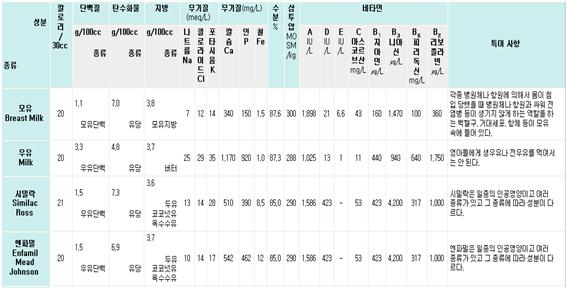
표 1-1(2).
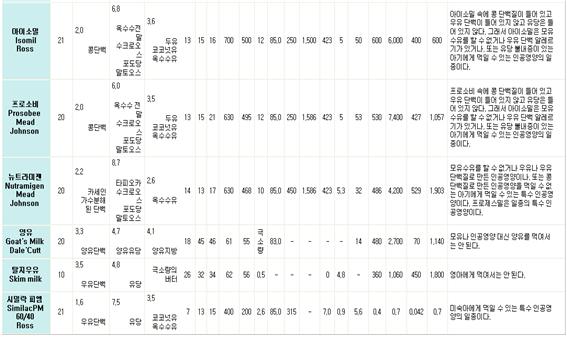
※ 인공영양의 성분과 성분의 용량이 다소 변경될 수 있다.
최근 거의 모든 인공영양에 DHA와 ARA의 성분이 포함되어 있다. 소스: 부모도 반의사가 되어야 한다―소아가정간호백과
The following is a one hundred question and answer on “Breastfeeding, Breast Structure, Breastfeeding Hormone Prolactin”. 모유수유, 유방 구조, 모유수유 호르몬 프로랙틴에 관한 백문 백답
Q.&A.
Breastfeeding, breast structure, the breastfeeding hormone prolactin
Q.
What is a breast?
A.
The mammary gland/breast, i.e., the breast is the outer branch that produces breast milk.
It is part of the female reproductive system.
The breast is located between the subcutaneous tissue of the anterior chest, between the 2nd to 6th ribs, between the great pectoral muscles, and between the sternum and axilla.
There is a nipple in the center of the breast. There is one nipple on each breast.
The part of the skin surrounding the root of the nipple is called the nipple ring, the areola, the nipple plate.
There is a Montgomery line on the areola. Here, sebum is secreted. (Refer to Figure 22-41)
Q. What is the internal structure of the breast?
A. There are 15-20 mammary gland lobes in one breast.
There are many mammary glands in each mammary gland.
The acinar gland is connected to the acinar gland.
The acinar gland secretory duct is connected to the bulge (flow).
The bulge (flow) is again connected to the duct (mammary duct).
The cannula is connected to the breast hole of the nipple.
Milk comes out of the breast hole in the nipple. (See picture breast)
Q. How does the breast produce milk?
A. When the baby sucks the nipple while breastfeeding and stimulates the areola→ Nerve impulse is transmitted to the hypothalamus of the brain→ A signal is sent from the hypothalamus to the posterior pituitary gland, where oxytocin (Pitocin) is secreted→ Oxytocin stimulating the acinar gland. It stimulates muscle epithelial cells → milk (breast milk) erupts from the acinar gland (mammary gland) → gland secretion duct → bulge → milk duct (milk gland duct) → nipples → milk is secreted through the nipple breast hole. Connective and adipose tissue is located between each mammary gland lobe.
Q. How is the breast developed?
A. Until puberty, the structure of male and female breasts is almost the same. When puberty begins, female hormones called estrogen and progesterone are secreted by the luteal body of a woman’s ovary.
The mammary glands (milk glands) and acinar glands (milk secretion ducts) are developed and enlarged by the mons.
And fat tissue accumulates in the breast. So, the breasts of adolescent girls are beautifully enlarged.

Photo 4-2. Raising a baby through breastfeeding has so many benefits and benefits for the baby.
The physical contact love that occurs when the mother’s skin and the baby’s skin come into contact with each other during breastfeeding, as well as being able to receive the intensive care and care given by the mother is also beneficial for the baby and for the mother.
It’s just passing by without knowing that this is the case.
A nursing baby can receive eye contact love from her mother and her mother can also receive eye contact love from her baby.
This love only occurs with babies and nursing mothers who are breastfeeding while breastfeeding. Copyright ⓒ 2013 John Sangwon Lee, MD., FAAP

Photo 4-3. Look at the baby’s gaze!
The mother’s gaze and the baby’s gaze contact love! Through this kind of eye contact love, the bonding of love between mother and child is firmly formed.
This bonding of love is formed more firmly when breastfeeding. Copyright ⓒ 2011 John Sangwon Lee, MD., FAAP

Photo 4-4. Look at the baby’s gaze! The mother’s gaze and the baby’s gaze contact love! Through this kind of eye contact love, the bonding of love between mother and child is formed more firmly. Copyright ⓒ 2011 John Sangwon Lee, MD., FAAP

Photo 4-5. See the love of physical contact in a nursing baby!
The love of physical contact between the mother’s body and the baby!
Through this kind of physical contact love, the bond of love between mother and child is formed more firmly. Copyright ⓒ 2011 John Sangwon Lee, MD., FAAP

Photo 4-6. Look at the physical contact of a nursing baby!
The love of physical contact between the mother’s body and the baby!
Through this kind of physical contact love, Mom-child love bonding is more firmly formed. Copyright ⓒ 2011 John Sangwon Lee, MD ., FAAP

Photo 4-7. There are many more things you need to feed on artificial nutrition. Copyright ⓒ 2011 John Sangwon Lee, MD., FAAP

Figure 4-1. After delivery, the uterus of a mother who is not breastfeeding is less affected by the Pitocin hormone and gradually contracts and recovers slowly. Copyright ⓒ 2011 John Sangwon Lee, MD., FAAP

Figure 4-2. After delivery, the breastfeeding mother’s uterus contracts and recovers faster under the influence of the Pitocin hormone. Copyright ⓒ 2011 John Sangwon Lee, MD., FAAP

Photo 4-8. There are several small nodules prominent in the papillary ring (areola, nipple plate). Those nodules are called Montgomery nodules. The Montgomery glands are located within the Montgomery tubercle. There, lubricating sebum-like cream is secreted. Copyright ⓒ 2011 John Sangwon Lee, MD., FAAP

Photo 4-9. Breast milk is at an appropriate temperature so that it can be eaten at any time without being warmed up. In the photo, the tip of the Montgomery projection on the areola is clearly visible. Copyright ⓒ 2011 John Sangwon Lee, MD., FAAP
Q.
You said that when you are pregnant, your breasts also change.
A.
When pregnant, many changes occur in the pregnant woman’s body. Among them, the more special and remarkable physical changes are those in the uterus and breasts.
Whether the future baby is born with breast milk or artificial nutrition, the pregnant woman develops acinar glands, lactation cells, and lactation glands in the breast so that my precious baby, who will be born in the future, can get enough milk and grow healthy.
In the breast, the mammary gland (the secretory relationship of the acinar gland), the bulge, and the milk duct (the mammary gland) are vigorously developed, the nipples are enlarged, the fat tissue in the breast is accumulated, and the entire breast is enlarged.
The Montgomery gland is developed in the areola, and sebum is produced there, making it more convenient for breastfeeding to proceed with all of the breasts. During the first time your breasts grow firmly, you may feel a little tingling and sore.
Especially if the nipples touch anywhere, it can be quite painful. There are 15 to 20 breast lobes in one breast. One breast lobe consists of several small breast lobules, The breast lobules are further subdivided again.
There are milk cells in the breast lobules that make milk.
Mammary cells gather to become mammary glands (acinar glands). This mammary gland is also called the acinar gland, or mammary gland.
The tube through which the milk made from the mammary gland flows is called the acinar gland secretion tube. It is called the acinar gland secretion relationship throughout the large and small acinar gland glands. (See picture breast)
The sinus in the breast where the milk secreted from the mammary gland is confined before the baby sucks on the nipple is called fluid or bulge. As soon as you become pregnant, the tissues of the lactation system inside the breast become larger and more developed.
And just before delivery, the function of the breast becomes more active without knowing it.
During pregnancy, by the action of the anti prolactin hormone secreted from the placenta, Prolactin stimulates the lactating cells of the acinar gland to prevent the secretion of milk.
After the baby is born, the placenta is in the uterus.
As soon as it is excreted, prolactin begins to stimulate the lactating cells and the lactating ducts begin to make milk.
However, it takes 1 to 2 days for prolactin to start working vigorously after delivery.

Figure 4-3. Breast milk secretion, dilation of the cervix, breast milk secretion stimulating hormone (prolactin), oxytocin hormone that expels breast milk into the flow of the breast, prolactin hormone secretion that can occur when nipples are sucked, prolactin secretion inhibitory hormone. Copyright ⓒ 2011 John Sangwon Lee, MD ., FAAP
Q.
How does breast produce milk?
A.
When a baby sucks a nipple, peripheral nerves in the nipple and areola are stimulated.
At this time, a signal that the baby sucks is transmitted to the hypothalamus in the nursing mother’s brain through a neural impulse.
In the hypothalamus, nerve impulses are transmitted to the posterior lobe of the pituitary gland of the nursing mother.
Oxytocin/Pitocin hormone is secreted from the posterior pituitary gland of a nursing mother, and the oxytocin hormone stimulates the muscle epithelial cells surrounding the acinar cells, causing the milk to be secreted into the acinar gland secretion duct.
It stimulates the acinar gland secretion relationship so that the breast milk that is already secreted into the flow in the breast lactation relationship from the milk cells in the breast flows out to the nipple through the acinar gland secretion relationship.
At the same time, the nerve impulse generated by sucking the nipple is transmitted to the hypothalamus of the nursing mother and then to the anterior pituitary gland.
Prolactin hormone is secreted in the anterior lobe of the pituitary gland in nursing mothers. The prolactin hormone stimulates the lactation cells (milk cells) of the breast to promote lactation.
At the same time, blood circulation in the breast becomes more vigorous, the adipose tissue in the breast is more developed, and the fat accumulates in the breast.
Venous blood vessels in the subcutaneous tissue of the breast grow so large that they can be easily seen with the naked eye through the breast skin layer. Because the breast grows during pregnancy, a glandular gland can form in the skin layer of the breast.
When the baby sucks after delivery, nerve impulses are transmitted to the hypothalamus and then to the posterior pituitary.
Oxytocin is secreted from the posterior lobe of the pituitary gland, and breast milk is expelled. During pregnancy, prolactin cannot stimulate breasts until the baby is born due to prolactin secretion-suppressing hormones secreted from the placenta.
When we learn all these physiology, we think that the physiology of our body is made similar to the function of a computer chip.
Q.
Do I have to wash off the nipples and nipple rings when there is a creamy thing during pregnancy?
A.
During pregnancy, the nipple grows to normal size, and there are 15-20 holes at the tip of the nipple that come out of the nipple.
The size of the areolas (nipple rings) around the roots of the nipples is also doubled. The color of the nipples and areolas changes to dark blackish-brown or deep pink. Perhaps the color of the nipples and areolas has changed so that the breastfeeding baby can easily see and find them with the naked eye.
There are normally several Montgomery nodules on the areola. In the Montgomery tubercle is the Montgomery gland, and cream-like lubricating sebum is secreted from it, which softens the areola and nipples so that the nipples and areolas do not split or burst during lactation. In other words, it is almost the same as oiling a machine to make it work. During pregnancy and during postpartum breastfeeding, lubricating sebum protects the nipples and areola. The creamy lubricious sebum from the Montgomery gland should not be washed off with soap. And there is no need to apply a special topical cream to the nipples or areolas.
Q.
The size of the breast is small, but will the baby get enough breast milk?
A.
There are many differences in breast size and shape depending on the pregnant woman. The breasts of all mothers, whether they are fairly large or small or sagged, are capable of secreting sufficient amounts of breast milk to allow one or both babies to eat and grow at the same time. The ultimate goal of the breast, which the pediatrician hopes for, is to give the baby a sense of stability and comfort, and to secrete enough warm breast milk so that the baby can eat and grow healthy. From around the 5th to 6th month of pregnancy, a few drops of clear milk may come out of several breast holes in the nipple. This is a kind of wet colostrum.

Figure 4-4. Breast and nipple rings. Copyright ⓒ 2011 John Sangwon Lee, MD ., FAAP

Figure 4-5. Breastfeeding and breast. Copyright ⓒ 2011 John Sangwon Lee, MD., FAAP

Figure 4-6. The correlation between the baby’s mouth, breasts, and nipples when breastfeeding is also. Copyright ⓒ 2011 John Sangwon Lee, MD., FAAP
Illustration of a non-pregnant adult woman’s breast, pregnant adult woman’s breast, breastfeeding adult woman’s breast

Figure 4-7. Comparison of breasts of non-pregnant women (a), breasts of pregnant women (b), and breasts of lactating women (c).
Women who are not pregnant have the smallest breasts.
This is because the acinar glands, flow, and mammary gland ducts (milk ducts) are much smaller than those in the breast of a nursing mother. The breasts of pregnant women are more developed and larger in the mammary glands.
The breast of a lactating woman is the largest and has a noticeable amount of fatty tissue.
The sagittal gland was also greatly developed.
The acinar gland duct is larger, the flow (bulge) is larger, and the mammary gland duct (milk duct) is also larger.
The nipples and areolas are also large. Source: Used with permission from Ross Laboratories, Columbus, Ohio 43216, Division of Laboratories, USA and Pediatric Family Nursing Encyclopedia.
Table Composition of mature breast milk, transitional breast milk, colostrum and cow’s milk 표 성숙 모유, 이행성(변이) 모유, 초유, 우유의 성분 비교표
| Breast milk,
colostrum milk
ingredient |
Breast milk | Cow’s milk | ||||||
| Mature Breast milk Secreted from the 15th to 15 months after delivery |
Transitional breast milk Secreted for 6 to 10 days after delivery |
Colostrum Secreted during the first 5 days after delivery
|
||||||
| Average | test range | Average | test range | Average | test range | Average | test range | |
| (kcal/liter) | ||||||||
| 747 | 446-1192 | 735 | 678-830 | 671 | 588-730 | 701 | 587-876 | |
| ml/liter | 3.127 | 1.867-4.989 | 3.076 | 2.838-3.474 | 2.808 | 2.461-3.055 | 2.934 | 2.457-3.666 |
| Specific gravity | 1.031 | 1.026-1.037 | 1.035 | 1.034-1.036 | 1.034 | – | 1.031 | 1.028-1.033 |
| Hydrogen ion concentration index | 7.01 | 6.4-7.6 | – | – | – | – | 6.6 | – |
| Solid quality, total (g/liter) | 129 | 103-175 | 133 | 105-156 | 128 | 100-167 | 124 | 119-142 |
| Ash, Total (g/liter) | 2.02 | 1.6-2.66 | 2.67 | 2.31-3.38 | 3.08 | 2.47-3.50 | 7.15 | 6.81-7.71 |
| Mineral (g/liter) | – | – | – | – | – | – | – | – |
| Positive electron element (㎎/liter) | 41 | – | 55 | – | 68 | – | 149 | 0.390-0.139 |
| Sodium (g/liter) | 0.172 | 0.064-0.436 | 0.294 | 0.192-0.539 | 0.501 | 0.265-1.37 | 0.768 | 0.392-0.139 |
| 0.189 | 0.080-0.350 | 0.536 | 0.170-1.21 | 0.956 | 0.330-2.24 | – | – | |
| Potassium (g/liter) | 0.512 | 0.373-0.635 | 0.636 | 0.528-0.769 | 0.745 | 0.658-0.870 | 1.43 | 0.38-2.87 |
| 0.553 | 0.425-0.735 | 0.692 | 0.450-0.910 | 0.581 | 0.220-0.790 | – | – | |
| Calcium (g/liter) | 0.344 | 0.173-0.609 | 0.464 | 0.23-0.628 | 0.481 | 0.242-0.656 | 1.37 | 0.56-3.81 |
| 0.271 | 0.207-0.372 | 0.320 | 0.166-0.420 | 0.261 | 0.180-0.364 | – | – | |
| Magnesium (g/liter) | 0.035 | 0.018-0.057 | 0.035 | 0.026-0.054 | 0.042 | 0.031-0.082 | 0.13 | 0.07-0.22 |
| Negative electron element (㎎/liter) | 28 | – | 37 | – | 40 | – | 108 | – |
| Phosphorus (g/liter) | 0.141 | 0.068-0.268 | 0.198 | 0.097-0.317 | 0.157 | 0.085-0.251 | 0.91 | 0.56-1.12 |
| Sulfur (g/liter) | 0.14 | 0.05-0.30 | 0.20 | 0.15-0.23 | 0.23 | 0.20-0.26 | 0.30 | 0.24-0.36 |
| Chlorine (g/liter) | 0.375 | 0.088-0.734 | 0.457 | 0.305-0.721 | 0.586 | 0.435-1.01 | 1.08 | 0.93-1.41 |
| Hyperpositive element (㎎/liter) | 13 | – | 18 | – | 28 | – | 41 | – |
| Very small substances | ||||||||
| Cobalt (㎎/liter) | 극소 | – | – | – | – | – | 0.6 | – |
| Iron (㎎/liter) | 0.50 | 0.20-0.80 | 0.59 | 0.29-1.45 | 1.0 | – | 0.45 | 0.25-0.75 |
| Zinc (㎎/liter) | 0.51 | – | 1.04 | – | 1.34 | – | 0.102 | – |
| Manganese (㎎/liter) | 극소 | – | 극소 | – | 극소 | – | 0.02 | 0.005-0.0067 |
| Zinc (㎎/liter) | 1.18 | 0.17-3.02 | 3.82 | 0.39-5.88 | 5.59 | 0.72-9.81 | 3.9 | 1.7-6.6 |
| Fluorine (㎎/liter) | 0.107 | 0.0-0.24 | – | – | 0.131 | 0.0-0.35 | – | 0.10-0.28 |
| IODINE (㎎/liter) | 0.061 | 0.044-0.093 | – | – | – | 0.045-0.450 | 0.116 | 0.036-1.05 |
| Selenium (㎎/liter) | 0.021 | – | – | – | – | – | 0.04 | 0.005-0.067 |
| Protein (g/liter) | ||||||||
| Tota | 10.6 | 7.3-20 | 15.9 | 12.7-18.9 | 22.9 | 14.6-68.0 | 32.46 | 28.16-36.76 |
Sources and references: Nelson textbook, 15 Edition p.121,
Pediatric nutrition handbook, American Academy of pediatrics, p.354
OTHERS
| Breast milk,
colostrum milk
ingredient |
Breast milk | Cow’s milk | |||||||
| Mature Breast milk Secreted from the 15th to 15 months after delivery | Transitional breast milk Secreted for 6 to 10 days after delivery | Colostrum Secreted during the first 5 days after delivery | |||||||
| 성분 | Average | test range | Average | test range | Average | test range | Average | test range | |
| carbohydrate | |||||||||
| Lactose | |||||||||
| Direct estimate (g/liter) | 71 | 49-95 | 64 | 61-67 | 57 | 11-79 | 47 | 49-50 | |
| Difference | 68 | 50-92 | 64 | 60-68 | – | – | – | – | |
| Fructose (g/liter) | 1.3 | – | – | – | – | – | – | – | |
| Glucosamine (g/liter) | – | 0.7-0.8 | – | – | – | 1.4-4.3 | 0 | – | |
| Galactosamine (g/liter) | – | 0.0-0.4 | – | – | – | 0.04-0.7 | 0 | – | |
| Inositol (g/liter) | 0.45 | 0.39-0.56 |
– |
– | – | – | 0.08 | 0.06-0.12 | |
| Citric acid (g/liter) | – | 0.35-1.25 | – | – | – | – | 2.54 | 2.15-2.9 | |
| Fat, TOTAL (g/liter) | 45.4 | 13.4-82.9 | 35.2 | 27.3-51.8 | 29.5 | 24.7-31.8 | 38.0 | 34.0-61.0 | |
| Cholesterol (㎎/liter) | 139 | 88-202 | 241 | 126-320 | 280 | 180-345 | 110 | 70-170 | |
| Free cholesterol (% of total amount) | 76.1 | – | 76.5 | – | 79.5 | – | – | 90-95 | |
| Phosphorus lipid (㎎/liter) | 10.5 | 7-14 | 15.5 | 11-20 | 12 | 6-17 | – | 53-70 | |
| vitamin | |||||||||
| Vitamin A (㎎/liter) | 0.61 | 0.15-2.26 | 0.88 | 0.58-1.83 | 1.61 | 0.75-3.05 | 0.27 | 0.17-0.38 | |
| Catotine (㎎/liter) | 0.25 | 0.02-0.77 | 0.38 | 0.23-0.63 | 1.37 | 0.41-3.85 | 0.37 | 0.12-0.79 | |
| Vitamin D (IU/liter) | – | 4-100 | – | – | – | – | – | 5.40 | |
| Tocophero (㎎/liter) | 2.4 | 1.0-4.8 | 8.9 | 4.0-18.5 | 14.8 | 2.8-30.0 | 0.6 | 0.2-1.0 | |
| TtHIAMIN (㎎/liter) | 0.142 | 0.081-0.227 | 0.059 | 0.023-0.105 | 0.019 | 0.009-0.034 | 0.43 | 0.28-0.900 | |
| Riboflavin (㎎/liter) | 0.373 | 0.198-0.790 | 0.369 | 0.275-0.490 | 0.302 | 0.120-0.453 | 1.56 | 1.16-2.02 | |
| Vitamin B6 (㎎/liter) | 0.18 | 0.10-0.22 | – | – | – | – | 0.51 | 0.40-0.63 | |
| Nicotinic acid (㎎/liter) | 1.83 | 0.66-3.30 | 1.75 | 0.60-3.60 | 0.75 | 0.50-14.5 | 0.74 | 0.50-0.86 | |
| Vitamin B₁₂ (㎍/liter) | – | 극소량 | 0.36 | 0.03-0.70 | 0.45 | 0.10-1.5 | 6.6 | 3.2-12.4 | |
| Folic acid (IU/liter) | |||||||||
| (a) | 1.4 | 0.9-1.8 | 0.2 | 0.15-0.25 | 0.5 | 0.10-1.5 | 1.3 | 0.2-4.0 | |
| (b) | 24.0 | 7.4-61.0 | – | – | – | – | 37.7 | 16.8-63.2 | |
| (c) | 7.3 | 2.3-17.6 | – | – | – | – | 12.6 | 2.8-43.6 | |
| Biotin (IU/liter) | 2 | 1-3 | – | – | – | – | 22 | 14-29 | |
| Pentothe
nic acid |
2.46 | 0.86-5.84 | 2.88 | 1.35-4.12 | 1.83 | 0.29-3.02 | 3.4 | 2.2-5.5 | |
| Vitamin C | 52 | 0-112 | 71 | 45-90 | 72 | 47-104 | 11 | 3-23 | |
|
Source: From George DR, De Francesca BA.Human milk in comparison to cow milk.in: Lebenthal E, ed. Textbook of Gastroenterology and Nutrition in Infancy and Childhood. 2nd ed. New York, NY: Raven Press; 1989:242-243 |
| Breast milk,
colostrum milk
ingredient |
Breast milk | Cow’s milk | ||||||
| Mature Breast milk Secreted from the 15th to 15 months after delivery | Transitional breast milk Secreted for 6 to 10 days after delivery | Colostrum Secreted during the first 5 days after delivery | ||||||
| Average | test range | Average | test range | Average | test range | Average | test range | |
| Tryptophan | 3.7 | 1.4-6.8 | 5.1 | 4.2-5.9 | 21 | 7.3-52 | 24.9 | 21.9-28.0 |
| Whey protein | 7 | 4-10 | – | – | – | – | 7 | 6-10 |
| Milk albumin | 3.6 | 1.4-6.0 | 7.8 | 6.9-8.6 | – | – | 2.4 | 1.4-3.3 |
| Milk globulin | – | – | 5.0 | 2.1-13.6 | 35 | 4.2-133 | 1.7 | 0.7-3.7 |
| Serum albumin | 0.32 | 0.20-0.47 | 0.37 | 0.26-0.65 | 2.5 | – | 0.4 | – |
| Serum immunoglobum
in |
0.09 | 0.02-0.27 | 0.36 | 0.01-0.96 | 1.0 | – | 0.8 | – |
| Amino acid
(g/liter) |
||||||||
| Total | 12.8 | 9.0-16.0 | 9.4 | 6.0-10.0 | 12.0 | 7.0-40.0 | 33.0 | 27.0-41.0 |
| Alanine | – | 0.36-0.42 | – | – | – | – | 0.75 | – |
| -Arginine | 0.43 | 0.28-0.64 | 0.63 | 0.48-0.73 | 0.74 | 0.62-0.96 | 1.4 | 1.2-1.6 |
| Aspartic acid | – | 0.89-0.98 | – | – | – | – | 1.7 | – |
| Cystine | – | 0.23-0.25 | – | – | – | – | – | – |
| Glutamic acid | – | 1.89-2.00 | – | – | – | – | 6.8 | – |
| Glycine | – | 0.23-0.24 | – | – | – | – | 0.11 | – |
| Histidine | 0.24 | 0.12-0.30 | 0.38 | 0.29-0.45 | 0.41 | 0.35-0.46 | 1.2 | 1.1-1.3 |
| Isoleucine | 0.61 | 0.41-0.92 | 0.97 | 0.73-1.21 | 1.01 | 0.88-1.15 | 2.5 | 2.1-2.9 |
| Leucine | 0.97 | 0.65-1.47 | 1.51 | 1.13-1.97 | 1.66 | 1.33-2.14 | 3.6 | 3.2-3.9 |
| Lysine | 0.70 | 0.36-0.93 | 1.13 | 0.88-1.48 | 1.18 | 0.95-1.41 | 2.6 | 2.3-3.1 |
| Meth
isonine |
1.12 | 0.07-0.16 | 0.24 | 0.16-0.34 | 0.25 | 0.19-0.36 | 0.8 | 0.6-0.9 |
| Phenylalanine | 0.40 | 0.24-0.58 | 0.62 | 0.48-0.71 | 0.70 | 0.60-0.84 | 1.8 | 1.5-2.2 |
| Proline | – | 0.84-0.94 | – | – | – | – | 2.5 | – |
| Serine | – | 0.47-0.51 | – | – | – | – | 1.6 | – |
| Trionine | 0.52 | 0.30-0.66 | 0.78 | 0.61-0.91 | 0.85 | 0.75-1.04 | 1.7 | 1.3-2.2 |
| Trimtopha | 0.19 | 0.14-0.26 | 0.28 | 0.23-0.32 | 0.32 | 0.25-0.42 | 0.6 | 0.4-0.8 |
| Trionine | – | 0.46-0.52 | – | – | – | – | – | – |
| Valine | 0.73 | 0.45-1.14 | 1.05 | 0.77-1.36 | 1.17 | 0.98-1.49 | 2.6 | 2.4-2.8 |
| Non-protein urea (mg/liter) | ||||||||
| Total | 324 | 173-604 | 479 | 425-533 | 910 | 510-1270 | 252 | 181-323 |
| Urea-N | 180 | 127-235 | 111 | – | – | – | 132.7 | 61.3-204 |
| Uric acid-N | 22 | 13-41 | – | – | – | – | 24.1 | 11.3-36.9 |
| Creatinine-N | 11 | 8-19 | – | – | – | – | 7.05 | 1.9-12.2 |
| Creatine-N | 11 | 2-41 | – | – | – | – | 40.35 | 24.5-56.2 |
| Amino acid-N | 50 | 28-113 | 44 | – | – | 40-120 | 6.8 | 1.7-11.9 |
| Choline-N | 10.3 | 6.2-16.8 | – | – | – | – | 12 | 5-19 |
| The enzyme (mg/liter) | ||||||||
| Raizojam | 390 | 30-3000 | – | – | 460 | 90-1020 | 0.13 | 0.00-2.6 |
Souce:: From George DR, De Francesca BA.Human milk in comparison to cow milk.in: Lebenthal E, ed. Textbook of Gastroenterology and Nutrition in Infancy and Childhood. 2nd ed. New York, NY: Raven Press; 1989:242-243
When invaded by various pathogens or antigens, breast milk contains leukocytes, giant cells, antibodies, etc. that fight the pathogens or antigens to prevent infectious diseases or allergic diseases.
Composition of breast milk, cow’s milk, goat’s milk, infant formula
표 모유, 우유, 양유, 인공영양의 성분 비교표

표 1-1(2).

※ The ingredients of artificial nutrition and the dosage of the ingredients may be slightly changed. The most recent artificial nutrition contains DHA and ARA ingredients. Source: www.drleepediatrics.com
출처 및 참조 문헌
- NelsonTextbook of Pediatrics 22ND Ed
- The Harriet Lane Handbook 22ND Ed
- Growth and development of the children
- Red Book 32nd Ed 2021-2024
- www.drleepediatrics.com 제1권 소아청소년 응급 의료
- www.drleepediatrics.com 제2권 소아청소년 예방
- www.drleepediatrics.com 제3권 소아청소년 성장 발육 육아
- www.drleepediatrics.com 제4권 모유,모유수유, 이유
- www.drleepediatrics.com 제5권 인공영양, 우유, 이유식, 비타민, 미네랄, 단백질, 탄수화물, 지방
- www.drleepediatrics.com 제6권 신생아 성장 발육 육아 질병
- www.drleepediatrics.com제7권 소아청소년 감염병
- www.drleepediatrics.com제8권 소아청소년 호흡기 질환
- www.drleepediatrics.com제9권 소아청소년 소화기 질환
- www.drleepediatrics.com제10권. 소아청소년 신장 비뇨 생식기 질환
- www.drleepediatrics.com제11권. 소아청소년 심장 혈관계 질환
- www.drleepediatrics.com제12권. 소아청소년 신경 정신 질환, 행동 수면 문제
- www.drleepediatrics.com제13권. 소아청소년 혈액, 림프, 종양 질환
- www.drleepediatrics.com제14권. 소아청소년 내분비, 유전, 염색체, 대사, 희귀병
- www.drleepediatrics.com제15권. 소아청소년 알레르기, 자가 면역질환
- www.drleepediatrics.com제16권. 소아청소년 정형외과 질환
- www.drleepediatrics.com제17권. 소아청소년 피부 질환
- www.drleepediatrics.com제18권. 소아청소년 이비인후(귀 코 인두 후두) 질환
- www.drleepediatrics.com제19권. 소아청소년 안과 (눈)질환
- www.drleepediatrics.com 제20권 소아청소년 이 (치아)질환
- www.drleepediatrics.com 제21권 소아청소년 가정 학교 간호
- www.drleepediatrics.com 제22권 아들 딸 이렇게 사랑해 키우세요
- www.drleepediatrics.com 제23권 사춘기 아이들의 성장 발육 질병
- www.drleepediatrics.com 제24권 소아청소년 성교육
- www.drleepediatrics.com 제25권 임신, 분만, 출산, 신생아 돌보기
- Red book 29th-31st edition 2021
- Nelson Text Book of Pediatrics 19th- 21st Edition
- The Johns Hopkins Hospital, The Harriet Lane Handbook, 22nd edition
- 응급환자관리 정담미디어
-
소아가정간호백과–부모도 반의사가 되어야 한다, 이상원
-
Neonatal Resuscitation American heart Association
-
Neonatology Jeffrey J.Pomerance, C. Joan Richardson
-
Pediatric Resuscitation Pediatric Clinics of North America, Stephen M. Schexnayder, M.D.
-
Pediatric Critical Care, Pediatric Clinics of North America, James P. Orlowski, M.D.
-
Preparation for Birth. Beverly Savage and Dianna Smith
-
Infectious disease of children, Saul Krugman, Samuel L Katz, Ann A. Gershon, Catherine Wilfert
- Pediatric Nutritional Handbook American Academy of Pediatrics
- 소아가정간호백과–부모도 반의사가 되어야 한다, 이상원
- The pregnancy Bible. By Joan stone, MD. Keith Eddleman, MD
- Neonatology Jeffrey J. Pomerance, C. Joan Richardson
- Preparation for Birth. Beverly Savage and Dianna Smith
- 임신에서 신생아 돌보기까지. 이상원
- Breastfeeding by Ruth Lawrence and Robert Lawrence
- Infectious disease of children, Saul Krugman, Samuel L Katz, Ann A. Gershon, Catherine Wilfert
- The Harriet Lane Handbook 19th Edition
- 제4권 모유, 모유수유, 이유 참조문헌 및 출처
- 제5권 인공영양, 우유, 이유, 비타민, 단백질, 지방 탄수 화물 참조문헌 및 출처
- 제6권 신생아 성장발육 양호 질병 참조문헌 및 출처
- 소아과학 대한교과서
- 그 외
|
Copyright ⓒ 2015 John Sangwon Lee, MD., FAAP 미국 소아과 전문의, 한국 소아청소년과 전문의 이상원 저 “부모도 반의사가 되어야 한다”-내용은 여러분들의 의사로부터 얻은 정보와 진료를 대신할 수 없습니다. “The information contained in this publication should not be used as a substitute for the medical care and advice of your doctor. There may be variations in treatment that your doctor may recommend based on individual facts and circumstances. “Parental education is the best medicine.” |